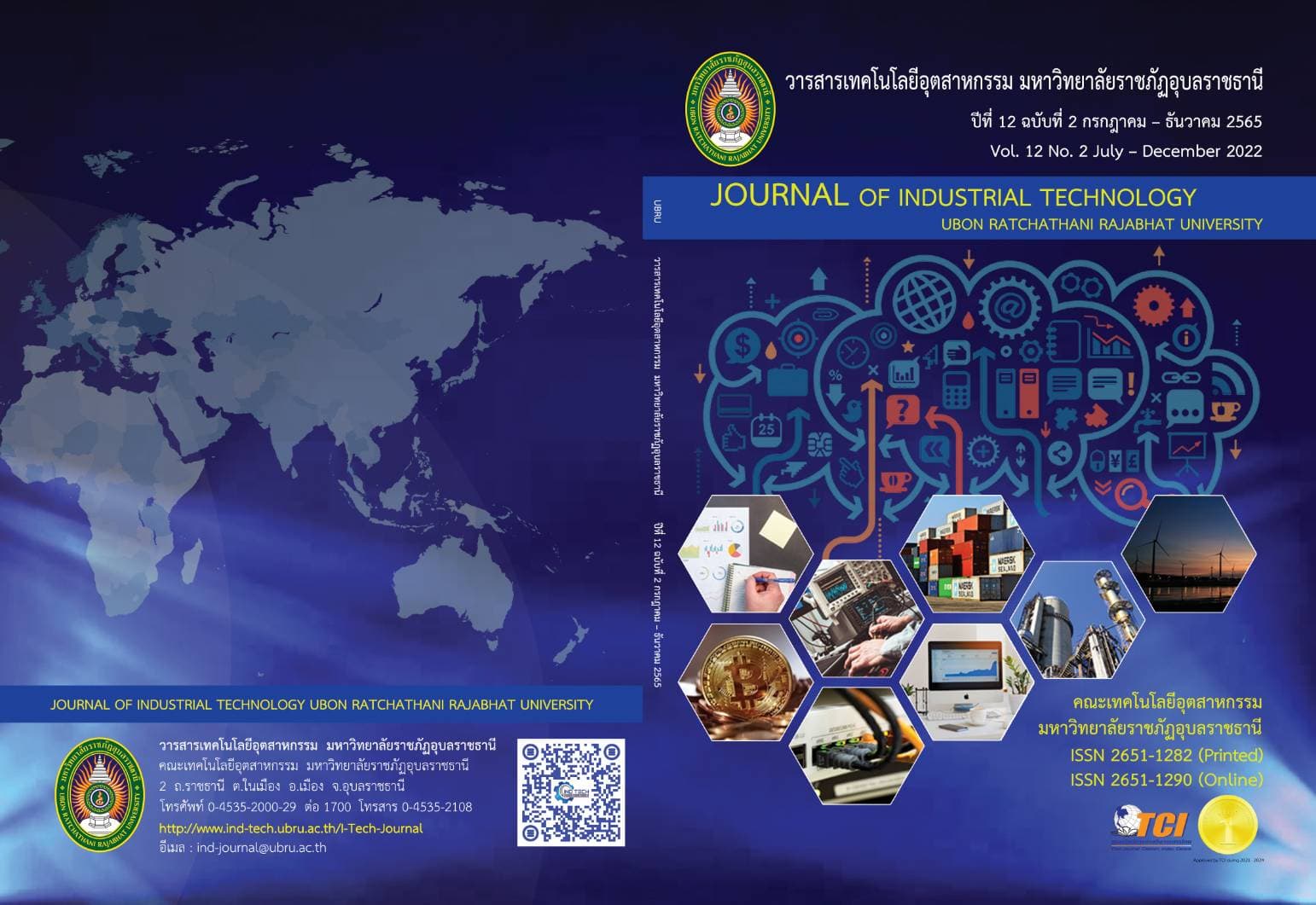Optimization of Medium Carbon Steel Welding Joint by Hot-Wire Gas Tungsten Arc Welding Using the Taguchi Method
Main Article Content
Abstract
Taguchi was a technique for designing and conducting experiments as a process of searching for the results obtained from experimental factors. Taguchi method was used for the Orthogonal array. Using the signal-to-noise ratio (S/N Ratio), which measures both the S/N Ratio of the number of variables in the response, and to get as close as possible to the mean of the desired target response. Therefore, this research has applied the Taguchi method to design an experiment to study the optimum factor of hot-wire tungsten arc gas welding process on medium carbon steel for the impact energy of the weld. By studying the factors of the process, such as welding current, hot wire current and welding speed. From the experiment, it was found that the optimum welding, the welding current of 150 Amp, the hot wire current of 180 Amp. and 100 mm/min of welding speed, the average maximum impact energy of 56.40 Joule and the S/N ratio is 35.02. In the repeated experiment, it was found that the values were close to the first experiment by calculating with Taguchi method, which was considered acceptable by estimated model coefficients of 97.37 %. Therefore, the Taguchi method can be used to design an efficient of hot-wire gas tungsten arc welding process on medium carbon joint.
Article Details

This work is licensed under a Creative Commons Attribution-NonCommercial-NoDerivatives 4.0 International License.
Articles published in Journal of Industrial Technology Ubon Ratchathani Rajabhat University both hard copy and electronically are belonged to the Journal.
References
Aichele, G., & Spreitz, W. (2001). Kostenrechnen und Kostensenken in der Schweißtechnik: Handbuch zum Kalkulieren, wirtschaftlichen Konstruieren und Fertigen. Verlag für Schweißen und Verwandte Verfahren, DVS-Verlag.
Ding, J., Colegrove, P., Mehnen, J., Ganguly, S., Almeida, P. S., Wang, F., & Williams, S. (2011). Thermo-mechanical analysis of Wire and Arc Additive Layer Manufacturing process on large multi-layer parts. Computational Materials Science, 50(12), 3315-22.
Wang, F., Williams, S., Colegrove, P., & Antonysamy, A. A. (2013). Microstructure and mechanical properties of wire and arc additive manufactured Ti-6Al-4V. Metallurgical and materials transactions A, 44(2), 968-77.
Hori, K., Myoga, T., Shinomiya, M., Watanabe, E., Kusano, K., Takuwa, T., & Hafuri, M. (1989). U.S. Patent No. 4,801,781. Washington, DC: U.S. Patent and Trademark Office.
Bai, J. Y., Fan, C. L., Yang, C. L., & Dong, B. L. (2016). Effects of thermal cycles on microstructure evolution of 2219-Al during GTA-additive manufacturing. The International Journal of Advanced Manufacturing Technology, 87(9), 2615-23.
Yilmaz, O., & Ugla, A. A. (2017). Microstructure characterization of SS308LSi components manufactured by GTAW-based additive manufacturing: shaped metal deposition using pulsed current arc. The International Journal of Advanced Manufacturing Technology, 89(1-4), 13-25.
Spaniol, E., Ungethüm, T., Trautmann, M., Andrusch, K., Hertel, M., & Füssel, U. (2020). Development of a novel TIG hot-wire process for wire and arc additive manufacturing. Welding in the World, 1-12.
Tanmay, Chandra, M., Sharma, S. et al.(2021). Study of Mechanical and Metallurgical Properties of Cold and Hot Reciprocating Wire TIG Welding on AISI 1035 Carbon Steel. J. Inst. Eng. India Ser. D .
He, H., Wu, C., Lin, S., & Yang, C. (2019). Pulsed TIG welding–brazing of aluminum -stainless steel with an Al-Cu Twin Hot wire. Journal of Materials Engineering and Performance, 28(2), 1180-9.
Shinozaki, K., Yamamoto, M., Nagamitsu, Y., Uchida, T., Mitsuhata, K., Nagashima, T., & Arashin, H. (2009). Melting phenomenon during ultra-high-speed GTA welding method using pulse-heated hot-wire. Quarterly Journal of the Japan Welding Society, 27(2), 22s-6s.
Wei, H., Zhang, Y., Tan, L., & Zhong, Z. (2015). Energy efficiency evaluation of hot-wire laser welding based on process characteristic and power consumption. Journal of Cleaner Production, 87, 255-62.
Kechagias, J. D., Aslani, K. E., Fountas, N. A., Vaxevanidis, N. M., & Manolakos, D. E. (2020). A comparative investigation of Taguchi and full factorial design for machinability prediction in turning of a titanium alloy. Measurement, 151, 107213.
Rafidah, A., Nurulhuda, A., Azrina, A., Suhaila, Y., Anwar, I. S., & Syafiq, R. A. (2014). Comparison design of experiment (doe): Taguchi method and full factorial design in surface roughness. In Applied mechanics and materials (Vol. 660, pp. 275-9). Trans Tech Publications Ltd.
Yu, G., Chen, X., Zhang, B., Pan, K., & Yang, L. (2020). Tensile-Shear Mechanical Behaviors of Friction Stir Spot Weld and Adhesive Hybrid Joint: Experimental and Numerical Study. Metals, 10(8), 1028.


